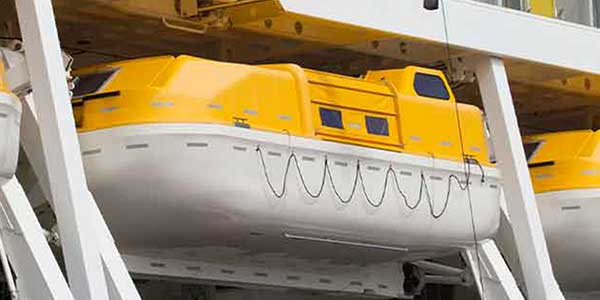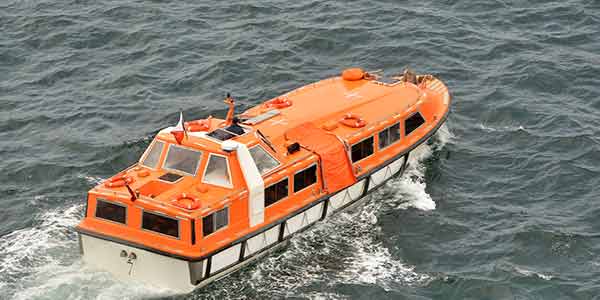How Many Lifeboats Are There On A Cruise Ship?
Maritime safety has come a long way since the Titanic was permitted to sail without enough lifeboats for everyone on board. Now, we take it for granted that everyone will have a spot in a boat if it was ever needed. But, it does make you wonder, how many lifeboats are there on a modern cruise ship?
A cruise ship with a capacity of 4000 persons will have at least 20 lifeboats. There must be enough capacity for at least 37.5% of passengers and crew to be accommodated in lifeboats on each side of the ship. The remaining capacity may be provided by liferafts.
The precise number of lifeboats depends on two factors.
- The capacity of each lifeboat.
- The number of persons on board.
The capacity of each lifeboat
Regular lifeboats on cruise ships are designed to accommodate 150 people. This is actually a hard limit, stipulated within the LSA Code:
“No lifeboat shall be approved to accommodate more than 150 persons.”
LSA Code
Most cruise lines use lifeboats that are designed to accommodate the maximum possible number of people.
1 lifeboat accommodating 150 people takes up less space than two lifeboats accommodating 75 people.
Not only that, but you only need one launching appliance and one set of machinery. This means that the cost of maintaining a single boat is less than the cost of maintaining two boats.
It is safe to assume that the lifeboats on all cruise ships will be designed to accommodate 150 persons because that is the most cost-effective configuration for the cruise lines.
The number of persons on board
The second consideration is the number of people that the ship is permitted to carry.
Each person on the ship must have a spot in a lifeboat should it ever be needed.
The implication of this is that there must be enough capacity for at least 50% of persons to be accommodated in lifeboats on either side of the ship.
This still holds true and is written down in international law within the Safety of Life at Sea (SOLAS) convention.
The convention does add a caveat though:
“The Administration may permit the substitution of lifeboats by liferafts of equivalent total capacity provided that there shall never be less than sufficient lifeboats on each side of the ship to accommodate 37.5% of the total number of persons on board.”
SOLAS
In the circumstances that 37.5% of the ship’s capacity is accommodated in lifeboats on each side, the rest will have space in a liferaft.
Liferafts will either be traditional davit launched liferafts, or more commonly today, a “Marine Evacuation System”. Either way, this additional capacity is provided by an inflatable survival craft.
Calculating how many lifeboats are on a cruise ship
To determine how many lifeboats a cruise ship needs, we assume that each boat has a capacity for 150 people and that 37.5% of the ship’s capacity will be accommodated on each side.
| Ship Capacity | Lifeboats |
| 800 | 4 |
| 1200 | 6 |
| 1600 | 8 |
| 2000 | 10 |
| 2400 | 12 |
| 2800 | 14 |
| 3200 | 16 |
| 3600 | 18 |
| 4000 | 20 |
Pro Tip: You can estimate the capacity of a cruise ship by counting how many lifeboats are on each side.
Can lifeboats accommodate more than 150 people?
The observant amount you will notice that there is a discrepancy between my figures and some of the modern, large cruise ships.
Some now have a capacity for nearly 9000 people, yet they might only have 18 “lifeboats”.
Going by our calculations, a ship that size should have around 22 lifeboats on each side or 44 lifeboats in total.
It turns out, there is scope within the regulations for lifeboats to be developed which exceed the maximum 150 person capacity.
You can read more detail in this article from the Royal Institute of Naval Architects: New 370 Person Mega Lifeboat And Davit System Developed.
The larger “lifeboats” have special arrangements, far in excess of traditional lifeboats. For example, they can be boarded and lowered straight from their stowage location, reducing embarkation time and eliminating the need for bowsing lines.
They are also configured for simultaneous boarding across two levels, effectively reducing the loading time by 50% from an equivalent capacity regular lifeboat.
You’ll also notice that these “lifeboats” are not actually called “lifeboats”. Instead, they are labelled as a “rescue vessel”.
What type of lifeboats on cruise ships?
Cruise ships carry two main types of lifeboats: partially enclosed lifeboats, and lifeboat tenders.
Partially enclosed lifeboats are the most common, and usually make up the bulk of the supply of lifeboats carried on a cruise ship.

In addition to partially enclosed lifeboats, cruise ships also carry lifeboat tenders.
Lifeboat tenders are a sub-set of partially enclosed lifeboats, but they carry additional equipment so that they can function as passenger tenders when the ship visits ports too small to dock in.

Lifeboat tenders are more expensive to maintain than regular lifeboats because of the additional equipment that they carry.
For this reason, a cruise ship will usually carry a limited supply of lifeboat tenders. They will have just enough to operate a passenger tender service.
When used in their function as a lifeboat, however, there is no significant difference between partially enclosed lifeboats and lifeboat tenders.
You can read more about the different sorts of lifeboats carried on ships in this article: What Types Of Lifeboats Are Used On Ships?
Are there enough lifeboats on a cruise ship if some get damaged?
Based purely on the capacity requirements of lifeboats, it would appear that you would need to use every single lifeboat to be able to evacuate a cruise ship.
In fact, we have only really discussed the minimum number of lifeboats for accommodating people in this article. There are additional requirements for spare capacity in liferafts, in addition to the requirements for capacity in lifeboats.
The spare liferaft capacity is in addition to the liferafts we discussed above which could substitute 12.5% capacity on either side.
SOLAS states:
“In addition, inflatable or rigid liferafts complying with the requirements of section 4.2 or 4.3 of the Code of such aggregate capacity as will accommodate at least 25% of the total number of persons on board.”
SOLAS
This means that in the event that a large proportion of the lifeboats on one side were rendered unserviceable, there would still be the capacity to evacuate the entire ship in an emergency.
The additional liferafts would fill in any remaining capacity required.
